- Home
- Lin Carter
Journey To The Underground World Page 3
Journey To The Underground World Read online
Page 3
I guess I had to be satisfied with that.
And so we started down. At the lip of the crater the width of the central shaft measured about two hundred feet in diameter and roughly six hundred feet in circumference. The great shaft yawned beneath us, seeming to go down and down forever, dwindling into inky darkness. It was a fantastic sight, I must admit; also, a frightening one. But we had not come all this way to sightsee; so I kicked Babe about, centered her above the shaft, and we began the descent.
The sides of the shaft were almost perpendicular, like the sides of a well; but there were jagged outcroppings and protuberances to watch out for, so I guided Babe down carefully, and very slowly, using the special spotlights we had ordered to be installed back at Cairo to illuminate the crater walls.
The sides of the shaft were thickly coated with lava, very porous and crumbling; in the enclosed space, Babe’s engine made a deafening racket. Bits and chunks of lava, jarred loose by the noise, went bouncing and ricocheting down. But the Professor reassured me that the dangers of creating a landslide were minute.
Well, he’d been right about everything so far; I would trust him to be right about this fact.
Jaws grimly set, I coaxed Babe down yard by yard. When we were about two hundred feet below the mouth of the crater, darkness closed in, thick and impenetrable, and I was very glad we had thought about installing those spots. Because now we really needed them.
If we so much as nudged against the side of the crater, or hit one of those projecting shelves or spurs of lava which jutted crazily out from the walls, seemingly at random, Babe could snap her rotors. We would still descend, of course, in that case, but a lot more quickly than we wanted to, and our landing would be a bad one.
The Professor was peering with fascination at the rock strata as we sank past the four-hundred-foot point. I suppose any geologist would have been fascinated by what he saw-he yelled, over the roar of the engine, stuff about “combustible carbons,““silurians,” and “primordial soil,“but I was too busy gritting my teeth to bother listening.
Above our heads the circular opening framed a disc of day, which dwindled to the size of a dime. Now we were entered into the regions of Eternal Night, where light of the sun has but seldom penetrated since the planet was formed. It was an eerie experience, even a thrilling one, to have gone where no human foot had ever gone before us.
I would have traded the thrill for my favorite table at the Cafe Umbala and a good stiff martini and a glimpse of Tabiz’s grin.
The glow of a flashlight lit the cabin and broke the gloomy pattern of my thoughts. By its glare, the Professor peered intently at his instruments.
“Two thousand five hundred feet, my boy,“he whispered hoarsely. “We are below the very base of Mount Zanthodon at this point … in fact, we are beneath the earth’s crust!”
I felt a momentary qualm of uneasiness go through me. Then I stiffened my spine and set my jaw firmly.
“How’s the radiation count?”
“Still the same amount of background radiation,“he murmured. “I do not anticipate that it shall rise to a level even remotely dangerous … the radioactivity released by the Jurassic explosion would have fallen
to harmless levels many millions of years ago … but what of the width of the shaft?”
“Still about the same,“I said tersely, estimating with my eye. “Doesn’t look as if it’s ever gonna narrow!”
Nor did it when we reached the depth of a mile, then five miles, then ten.
And so we continued our descent into the regions of Eternal Night and our journey to the Underground World.
Chapter 4. BENEATH THE EARTH’S CRUST
At the depth of twenty-five miles the barometric apparatus we had used to measure our depth became thoroughly useless, as the weight of the air in the shaft accumulated beyond that of sea level. We switched over to the manometer, which was inefficient for some reason.
The air, although dense, was still perfectly breathable and even fresh. I suppose the volcanic shaft above us acted as a colossal chimney, drawing the stale cavern air out and replacing it with fresh air from the surface above. The pervading temperature had grown considerably warmer, but certainly not unendurable. We began shedding our outer garments.
At this depth, the lava walls were gorgeously colored, and the coating had formed into swelling blisters very curious to see. Crystals of opaque quartz and veins and splatters of once-liquid glass blazed and glittered awesomely in the light of our lamps. It was a fairyland of dazzling light and color … no more gorgeous or fantastic a sight could have met the eyes of Aladdin, when he descended into the caverns of the Wonderful Lamp.
The profuse wealth of minerals must have thrilled the Professor to the core. He jumped up and down in the bucket seat, peering nearsightedly at the wealth of mineral specimens that moved past our view, scribbling feverishly in his little black notebook, making excited comments to me in a highsqueaky voice.
We could no longer accurately measure our depth because of the unexpected failure of the manometer; but about an hour later, when we must have reached a depth of more than thirty miles, we became increasingly aware of a most peculiar phenomenon.
The darkness, which had been as impenetrable as a sea of black ink, began to … lighten.
At first, we didn’t notice it, because we were still descending through a zone of sparkling quartz and streaked glass. The gradual fading of the eternal dark we consigned to the ten thousand flickering, wandering reflections of our spotlights.
But when we had passed below that glittering zone, we could no longer fail to notice the ebbing of the midnight dark of the abyss, and its peculiar dawn-like lightening.
“I wonder if the residual radioactivity could possibly be reacting with chemicals in the rock, causing an effect similar to that of phosphorescence,“the Professor mused.
I couldn’t say, myself, but was heartily glad for every bit of light I could get. For the shaft had narrowed considerably in the last half-mile, and steering Babe on a safe descent had become increasingly tricky.
At the depth of about thirty-eight miles, the queer, seemingly sourceless light had strengthened almost to the intensity of late afternoon sunlight. We could clearly make out the veins and contours and variegated hues of the mineral strata as we sank past them, even without the use of artificial light.
At about forty-two miles down, we began to notice something else that was every bit as exciting to the professor. Rock-mold and spongy lichens grew in scabrous patches along the fissures in the rock walls of the crater shaft, and we descended past a level shelf-like outcropping covered with fantastic pale-yellow mushrooms a foot high.
“Dear Darwin! Just think of it, my boy,“the Professor marvelled in hushed tones. “There is life even at this depth within the earth … !”
It had grown increasingly warmer until the temperatures within the cabin of the helicopter were swampy and tropical. Sweat poured off us, soaking through our khaki clothing; but the heat was nothing at all like the suffocating warmth I had imagined we would find here beneath the earth’s crust.
And the air still smelled fresh and moist.
Although the volcanic shaft narrowed a bit more, somewhere around the depth of sixty or seventy miles beneath the surface, it still afforded sufficient leeway for Babe to continue descending.
I began to wonder if the shaft had any bottom at all, and entertained wild fantasies of flying directly through the earth until we came out the other side! This was sheerest nonsense, of course; but, still and all, it did begin to seem that we could keep on going down into the earth’s core forever.
Thankfully, there didn’t seem to be much worry about our running out of fuel. I had loaded Babe with subsidiary gas tanks everywhere subsidiary gas tanks could be tied, strapped, bolted or stored aboard the chopper. And this sort of straight-down descent didn’t really consume much gas at all.
But after some hours of this, I began to get weary. The nervous tension of inch
ing Babe down, keeping one eye on the walls and the other peeled for unexpected spurs and projections, had begun to wear my strength down.
The Professor volunteered to spell me at the controls while I napped. I taught him exactly what to do and impressed upon him the importance of keeping his mind on what he was doing and ignoring the scenery.
“Leaping Lindbergh, my boy!“he said scoffingly. “I was flying before you were born-”
“Yeah, but not helicopters, I don’t think,“I retorted rather ungrammatically.
I suppose it was pretty dumb of me to turn the controls over to the living stereotype of the “absent-minded professor,“but I was bushed and simply had to get a little shut-eye. And I didn’t think anything much could possibly happen: the shaft was still roomy enough to make it easy for a pilot to steer Babe’s rotors away from dangerous projections, and the descent was actually a lot easier and less risky now that the peculiar luminosity had increased almost to the strength of daylight.
So I climbed in the back, curled up among the gas tins, pulled my flight jacket over my shoulders, and dozed off.
I awoke with a sudden start when the world turned upside down with a bang and I flew out the cabin door, which had sprung open.
I ended up on my back on a mossy bank, head throbbing to the reverberations of the crash. I looked around wildly, wondering if I was still in my dream.
Whatever it was, this was surely no dream! I have had a few wild ones in my time, but never a dream to match the likes of this baby ….
Above me stretched an oddly luminous sky, with clouds aplenty but no sun in sight.
And the sky was not blue, but a peculiar shade of golden green, like nothing I have ever seen before. I looked up
And there was a hole in the sky.
It was almost directly overhead. Round and ragged-edged, and blurry, as if the intervening atmosphere were thick with steamy vapors.
Of course, I knew what it was.
The end of the volcanic shaft…
I looked down at my feet. My boots were sunk in wet loam. Farther up the slope, thick blue moss grew, starred with fleshy blossoms startlingly colored. Salmon pink and sulphur yellow they were, and they resembled sea anemones more than any flowers I had ever seen.
I raised my eyes.
Babe lay half sunk in the shoulder of the slope, one of her rotors snapped off near the hub, and the rotor-shaft itself still revolving with a flap-flap sound. Her plexiglass cabin was severely dented and cracked by collision with the ground, and one of the two cabin doors was dangling open on broken hinges. That must have been the one I was thrown out of.
I looked around.
The chopper had crashed in the slope of a rounded hill near the edge of a wide river or perhaps a lagoon.
The water was murky, dull green, and bubbly with froth. The fringe of sand about it was dun colored, littered with pebbles and broken shells and bits of wood. The hill rose behind where Babe had come to rest to greet the margin of a forest. It was a most queer looking forest, indeed, made up of tall, feathery trees which looked like an odd cross between bamboo and willow.
Tree ferns? I thought, my mind spinning crazily.
The forest was a veritable jungle, and the trees seemed rooted in glaucous, slimy mud. Some of the trees seemed familiar enough-hemlocks and cypresses and soaring redwoods-not too much different from the varieties known to me. But other trees were like nothing known to me: there was a very common broad-leafed tree rather resembling a gingko, its little fan-shaped leaves close-set on thick, squirming boughs like the tentacles of an octopus.
The air was steamy, moist and humid. And rank with the odors of the lagoon, stale mud, stagnant water, rotting vegetation. The ground was thick with moss, but I saw nothing in sight resembling ordinary grass or bushes or flowers.
From the slight elevation on which I stood, I could see that the cavern world, if such indeed it was-and such indeed it was-was of enormous, virtually unlimited extent.
I could see no horizon; the steamy air thickened, blurring far details. A ragged line of blue-green trees marked a jungle beyond the little lagoon, with dim hills beyond that, and then-vision ended.
I had a sudden crazy hunch that this was a land that time had forgotten-a leftover from the prehistoric past! Memories of Burroughs’ Pellucidar, the world at the earth’s core, spun dizzily through my brain.
Then the mud stirred and a clumsy shape came shouldering between the tall trees, and I stared into a grinning, lipless mouth lined with bristling fangs.
And the world went mad.
The thing was only, I suppose, about three or four feet long; but, then, so’s a king cobra. It was squat and bowlegged and built low to the ground and it walked with an odd, lurching waddle of a gait because its hind legs were longer than its forelegs. It was a mossy dark green all over its warty, armored hide, except in throat and belly, where the color paled to a muddy yellow. It had two rows of bony plates down its back and along the length of its thick, alligator-like tail.
But its head wasn’t much like an alligator’s, being neckless and snubby in the snout. Under bony brows, its eyes were unwinking pits of bright ferocity, unnervingly scarlet. When it grinned, both jaws proved lined with sharp white fangs longer than my fingers.
There were an awful lot of them, those fangs … .
It gave me a long, unwinking gaze, then waddled around behind the wrecked helicopter. I heard a pounce, a squeal; and it emerged into view chewing on something that dribbled raw crimson down its pulsing throat.
And quick fear welled up within me-
“Professor!“I squawked, grabbing at my hip with shaking fingers, trying to fumble open the snap on the holster strapped to my waist, where a well-oiled .45 reposed.
I ran around to the other side of the chopper, and stopped so suddenly a viewer might have thought I had collided with an invisible wall. For there he stood, sun helmet askew, pince-nez tilted to one side, a bruise on his cheekbone, but otherwise (as far as I could see) all in one piece. He stared after the reptile as it waddled unhurriedly away to finish its meal.
“Eh? What, my boy?”
“Just wanted to make sure that wasn’t a piece of you that pint-sized croc was nibbling,“I breathed, woozy with relief.
In his rapt, entranced state he scarcely heard me.
“Oh, by Linnaeus, Lamarck and Lydekker, my boy, isn’t it purely wonderful,“he murmured dreamily, gazing after the retreating reptile.
“Ugliest damn croc I ever saw,“I said rudely. He blinked vaguely.
“Eh, my boy? … Yes, you’re right … well, it is not exactly a true crocodile, but close enough, close enough … give the poor creature another thirty million years or so, and it will evolve into your true and genuine Crocodylus niloticus … unless, of course, evolution and its forces have been suspended here, as I more than half suspect to be the case … how beautiful!“he sighed, staring after the repulsive creature.
“Beautiful?“I repeated, with a snort. “All depends on taste, I suppose. Give me Ursula Andress in a bikini, and you can keep all the dwarf crocs in the world …”
But he was paying no attention to me, staring after the reptile. “Protosuchus,“he whispered, “as I live and breathe! … and hitherto found only in Triassic strata in Arizona … a descendant of the phytosaurs …
utterly remarkable!”
“You mean that was a dinosaur?“I demanded, my voice rising into a squeak at the end.
“Yes, my boy,“he said dreamily, “that was certainly a dinosaur.”
Welcome to Zanthodon, I thought to myself, feebly.
Part Two
THE UNDERGROUND WORLD
Chapter 5. LAND OF MONSTERS
Now that my fears concerning the Professor’s safety were relieved, we had time to compare notes. It seems that the helicopter had emerged so suddenly into the vast open space, that it had taken Potter quite by surprise.
As I had not instructed him how to land the chopper there being no particular
reason to teach him that he did the best he could in the few moments available to him.
We checked out Babe, and she was a sorry sight. Although not as much a total loss as she would have been had the gas tanks exploded, she was still a long ways from being airworthy. One rotor blade was snapped off short; another was bent. We would require the services of a blacksmith in setting that part of the damage to right. And where, in all of this incredible cavern-world, could we expect to find a smithy?
The Professor-predictably-was fascinated by his discovery. While I peered and poked and pried at the undercarriage, trying to ascertain the extent of the damage, he stared about him in dazzled wonder.
“Incredible, my boy, simply incredible!“he breathed enthusiastically. “Zanthodon is even more miraculous than I had dreamed … those trees over there are Jurassic conifers, extinct in the upper world for untold ages.”
“Yeah? And what are those feathery bamboo-type things?“I grunted, nodding at the tall growths which fringed the lagoon.
“Cycads, my boy … tree-ferns, likewise extinct. Utterly marvelous: a paleontologist’s dream come true!”
He had expected to find some interesting fossils, so I can readily understand his excitement at finding them alive and well, flourishing here beneath the earth’s crust where the temperature was humid, subtropical, and-above all-stable.
“Did you expect this place to be so big?“I inquired, rising to my feet and dusting off my knees. He shook his head, sun helmet wobbling.
“Not precisely . I estimate the cavern-world as being about five hundred miles by five hundred, almost perfectly circular,“he mused. That didn’t sound like so much to me, and I said so.
He snorted. “That means Zanthodon consists of a quarter of a million square miles, my boy.”
“That much?”

 Zanthodon
Zanthodon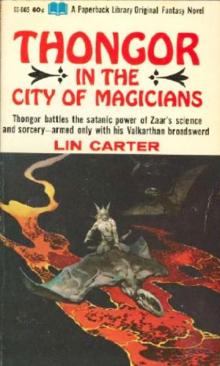 Thongor in the City of Magicians
Thongor in the City of Magicians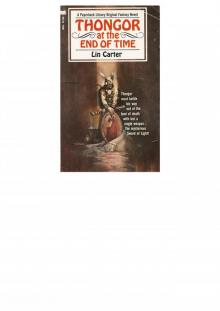 Thongor at the End of Time
Thongor at the End of Time The Valley Where Time Stood Still
The Valley Where Time Stood Still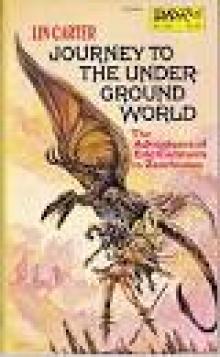 Journey To The Underground World
Journey To The Underground World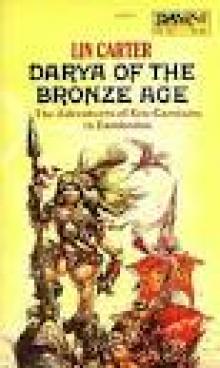 Darya of The Bronze Age
Darya of The Bronze Age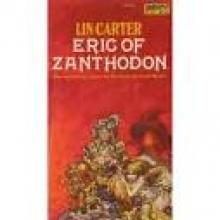 Eric of Zanthodon
Eric of Zanthodon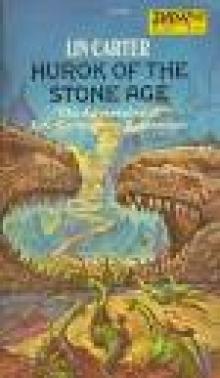 Hurok Of The Stone Age
Hurok Of The Stone Age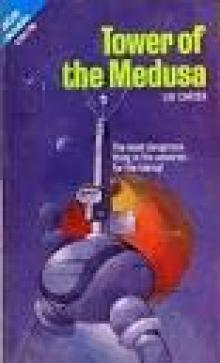 Tower Of The Medusa
Tower Of The Medusa Thongor Fights the Pirates of Tarakus
Thongor Fights the Pirates of Tarakus The Zanthodon MEGAPACK ™: The Complete 5-Book Series
The Zanthodon MEGAPACK ™: The Complete 5-Book Series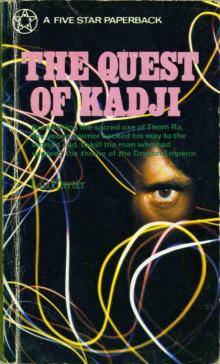 The Quest of Kadji
The Quest of Kadji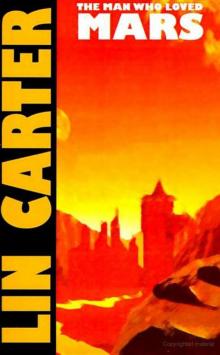 Lin Carter - The Man Who Loved Mars
Lin Carter - The Man Who Loved Mars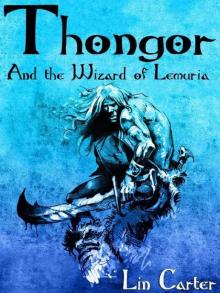 Thongor and the Wizard of Lemuria
Thongor and the Wizard of Lemuria The Nemesis of Evil
The Nemesis of Evil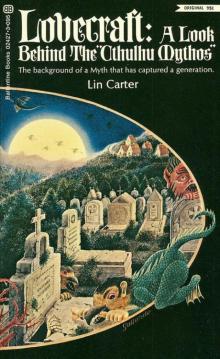 H.P.Lovecraft: A Look Behind Cthulhu Mythos
H.P.Lovecraft: A Look Behind Cthulhu Mythos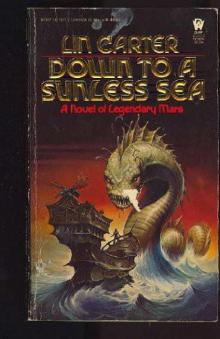 Lin Carter - Down to a Sunless Sea
Lin Carter - Down to a Sunless Sea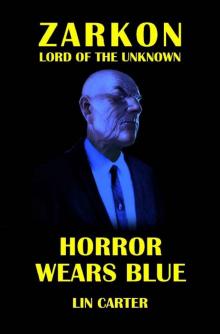 Horror Wears Blue
Horror Wears Blue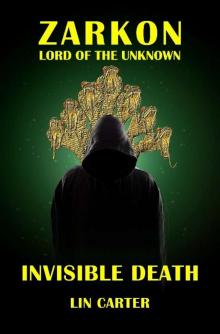 Invisible Death
Invisible Death Lin Carter - The City Outside the World
Lin Carter - The City Outside the World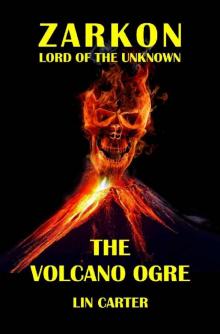 The Volcano Ogre
The Volcano Ogre The Man Who Loved Mars
The Man Who Loved Mars